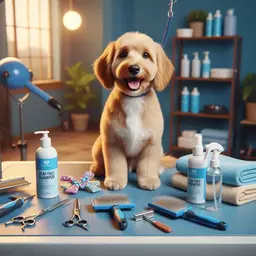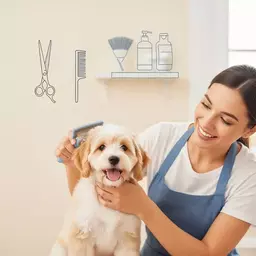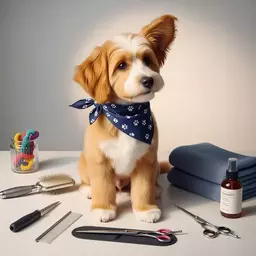Short Coats: Low Maintenance
- •Sleek & smooth fur
- •Minimal tangling
- •Breeds: Beagles, Boxers, French Bulldogs, Dalmatians
Care: Regular brushing, occasional baths.
Understanding your puppy's coat type can be a game changer for their grooming and overall health. Did you know that different breeds have unique grooming needs? This knowledge empowers you to provide the best care for your furry friend!
This visual summarizes the different puppy coat types, their characteristics, and specific grooming requirements, guiding owners toward better care practices.
Care: Regular brushing, occasional baths.
Care: Regular brushing to prevent mats, consistent routine.
Care: Daily brushing, professional grooming, slicker brush.
Impact: Affects shedding, insulation, and specific grooming needs.
Benefit: Texture guides tool selection & frequency.
Mistake: Assuming all puppies in a breed are identical.
As a seasoned pet grooming expert, I can’t stress enough the importance of understanding your puppy's coat type. This knowledge not only helps in choosing the right grooming tools but also plays a vital role in your puppy's overall health and comfort. Different coat types require different care, as highlighted by resources like the VCA Animal Hospitals guide on grooming and coat care, so let's dive into the various types and what they mean for your furry friend!
Identifying your puppy's coat type can seem daunting, but it’s essential for effective grooming. Here are the main categories:
Each of these coat types has its own characteristics, and knowing them helps you maintain your puppy’s coat effectively.
Short coats are typically low-maintenance. Breeds like French Bulldogs and Dalmatian have smooth, short fur that doesn’t tangle easily. Their grooming needs are minimal—just regular brushing to remove loose hair and occasional baths to keep them clean. This makes them a great choice for busy pet owners!
Medium coats strike a balance between ease and beauty. Breeds such as Bearded Collies and Border Collies have coats that require regular brushing, but they reward you with stunning looks. It’s crucial to create a grooming routine that fits their needs, ensuring they stay healthy and stylish.
Long-coated breeds like the Shih Tzu and Yorkshire Terrier demand more attention. Their beautiful flowing fur can get tangled, so regular grooming sessions are essential. I recommend using a slicker brush and investing in good quality grooming tools to keep their coats in top condition!
Understanding whether your puppy has a single or double coat is vital! Single-coated dogs, like the Chihuahua, have one layer of fur, while double-coated breeds, like Siberian Huskies, have a soft undercoat and a tougher outer coat. This difference affects shedding patterns and grooming needs, as detailed by Wisdom Panel's insights on dog coat types and care, so knowing what you have will help keep your puppy happy and healthy.
Now that we’ve covered the different coat types, let’s talk about how to identify your puppy’s specific coat type. This process isn’t as tricky as it sounds!
Take a close look at your puppy’s fur. Is it fine and smooth, or is it thick and fluffy? You can also check for thickness at the base of the hair. Visual cues can help you determine whether you’re dealing with a short, medium, or long coat.
One common mistake is assuming all puppies in a breed have the same coat type. Each puppy can vary significantly! It’s also important not to overlook the puppy's age, as puppies sometimes have different coat types that change as they mature.
Coat texture can also indicate your puppy's grooming needs. For example, curly coats (like Poodles) require regular trimming to stay managed, while wavy coats (such as Irish Setters) need brushing to prevent mats. Straight coats are usually the easiest to care for!
Identifying your puppy’s coat type is the first step in establishing a grooming routine that suits their needs. At *Puppies Inc. Grooming*, we’re here to guide you through this process and ensure your pup looks and feels their best!
Did you know? Regular grooming not only helps maintain your puppy's coat but also promotes skin health. Make it a bonding experience by incorporating gentle brushing into your daily routine. Use treats to reward your puppy for their cooperation, creating a positive association with grooming sessions!
Knowing your puppy's coat type is crucial for selecting the right grooming tools and establishing an effective grooming routine. This helps prevent mats, reduces shedding, and contributes to your puppy's overall health and comfort.
The main categories include short coats, medium coats, and long coats. Additionally, understanding whether your puppy has a single coat or a double coat is also very important for proper care.
Long-haired puppies, like Golden Retrievers or Shih Tzus, require frequent grooming, often daily brushing, to prevent severe tangles and mats. Professional grooming is also recommended periodically.
A single coat consists of one layer of fur (e.g., Chihuahuas), while a double coat has a soft undercoat for insulation and a tougher outer coat for protection (e.g., Siberian Huskies). This distinction impacts shedding, insulation, and grooming needs.
Yes, a puppy's coat can sometimes change as they mature. It's important to observe these changes and adjust your grooming routine accordingly.
As we wrap up our discussion on puppy coat care, it's essential to remember the different puppy coat types and how they impact grooming practices. Whether your furry friend has a short, medium, or long coat, understanding these differences can lead to better care and a happier pup! Let's recap the main points about coat types and identifying them effectively, drawing on general best practices for dog care and grooming from the AVMA.
Identifying your puppy's coat type is the first step in creating a personalized grooming routine. Here’s a quick overview:
By recognizing these characteristics, you can tailor your approach to grooming, ensuring your puppy stays comfortable and looking their best. Remember, visual identification techniques also play a key role in assessing your puppy's needs!
At Puppies Inc. Grooming, we believe that establishing a consistent grooming routine is crucial for your puppy’s health and happiness. Regular grooming not only keeps their coat healthy, but it also strengthens your bond with your furry companion. Here are a few important points to keep in mind:
By following these guidelines and adapting your grooming routine to suit your puppy’s unique needs, you’ll foster a happier and healthier pup. Happy grooming!
As we conclude this section, I encourage you to continue exploring the world of puppy coat care and grooming. Knowledge is key, and the more you learn, the better equipped you’ll be to care for your furry friend!
To help you on your journey, here are some fantastic resources:
These resources will not only enhance your knowledge but also connect you with other passionate dog owners!
We’d love to hear from you! Share your thoughts and experiences on puppy grooming with us. What tips have worked for you? What challenges have you faced?
Engagement with our community helps everyone learn and grow. At Puppies Inc. Grooming, we’re here to support each other in providing the best care for our pups. Let’s keep the conversation going!
Here is a quick recap of the important points discussed in the article:

 Every puppy deserves a grooming experience that is not only beneficial for their health but also str
Every puppy deserves a grooming experience that is not only beneficial for their health but also str
 Did you know that a consistent grooming routine can significantly enhance your puppy's health and ha
Did you know that a consistent grooming routine can significantly enhance your puppy's health and ha
 Curious about how to properly groom your puppy based on their unique breed? Each breed has specific
Curious about how to properly groom your puppy based on their unique breed? Each breed has specific
 Grooming your puppy isn't just about style; it’s a vital part of their health and happiness. As yo
Grooming your puppy isn't just about style; it’s a vital part of their health and happiness. As yo